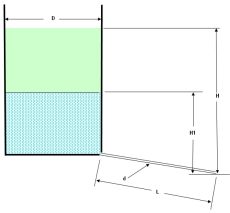Tank level.xls

Description
Calculation of time taken for level to drop from H to H1 in a tank with known diameter and discharge piping (length, diameter, fittings). Direct(integrated) and iterative methods have been used to check the accuracy. Author Dino Dzananovic.
Calculation Reference
Fluid Mechanics
Hydraulics
Calculation of the time taken for the level to drop from H to H1 in a tank with a known diameter and discharge piping involves two main methods: direct (integrated) method and iterative method.
- Direct (Integrated) Method:
In the direct method, the time taken for the level to drop from H to H1 is calculated using the following equation:
t = (A1 - A2) * (H - H1) / Q
where t is the time taken for the level to drop, A1 is the cross-sectional area of the tank, A2 is the cross-sectional area of the discharge piping, H is the initial level of the liquid in the tank, H1 is the final level of the liquid in the tank, and Q is the discharge flow rate through the piping.
The cross-sectional area of the tank (A1) can be calculated using the formula A1 = π*(D/2)^2, where D is the diameter of the tank.
The cross-sectional area of the discharge piping (A2) can be calculated using the formula A2 = π*(d/2)^2, where d is the diameter of the piping.
The discharge flow rate (Q) can be calculated using the appropriate fluid mechanics equations, considering the length, diameter, fittings, and other parameters of the discharge piping.
- Iterative Method:
In the iterative method, an iterative process is used to determine the time taken for the level to drop from H to H1. The process involves calculating the level of the liquid in the tank at regular intervals of time, based on the discharge flow rate and other parameters of the system.
The iterative method involves the following steps:
Step 1: Assume a value for the time interval (Δt), which is typically a small fraction of the total time taken for the level to drop.
Step 2: Calculate the level of the liquid in the tank at the initial time (t = 0), using the initial level (H) and the cross-sectional area of the tank (A1).
Step 3: Calculate the discharge flow rate (Q) at the initial time, using the appropriate fluid mechanics equations.
Step 4: Calculate the volume of liquid discharged from the tank during the time interval (Δt), using the discharge flow rate (Q) and the time interval (Δt).
Step 5: Calculate the new level of the liquid in the tank at the end of the time interval (t = Δt), by subtracting the volume of liquid discharged from the initial level (H).
Step 6: Repeat steps 3 to 5 for each time interval, until the level of the liquid reaches the final level (H1).
Step 7: Calculate the total time taken for the level to drop from H to H1, by summing the time intervals used in the iterative process.
Overall, both the direct and iterative methods can be used to calculate the time taken for the level to drop from H to H1 in a tank with a known diameter and discharge piping. The choice of method depends on the accuracy and complexity required in the calculation, as well as the available data and resources.
Calculation Preview
Full download access to any calculation is available to users with a paid or awarded subscription (XLC Pro).
Subscriptions are free to contributors to the site, alternatively they can be purchased.
Click here for information on subscriptions.

